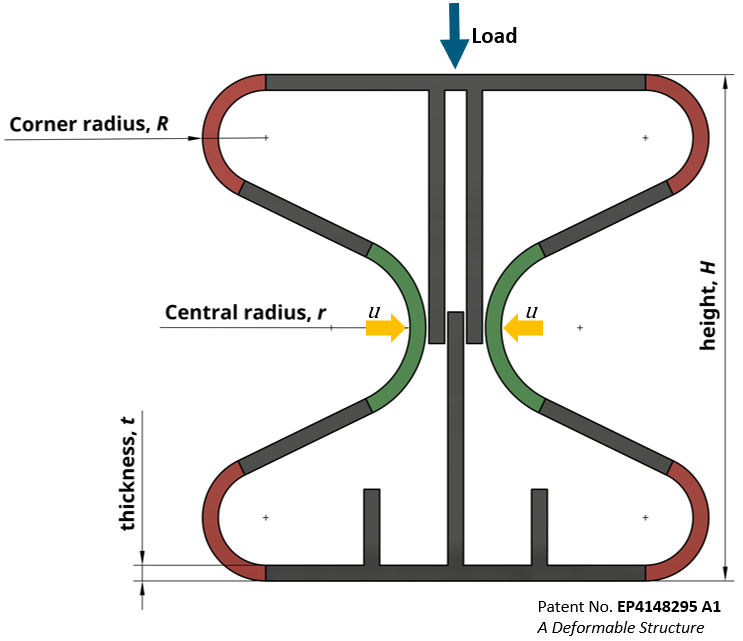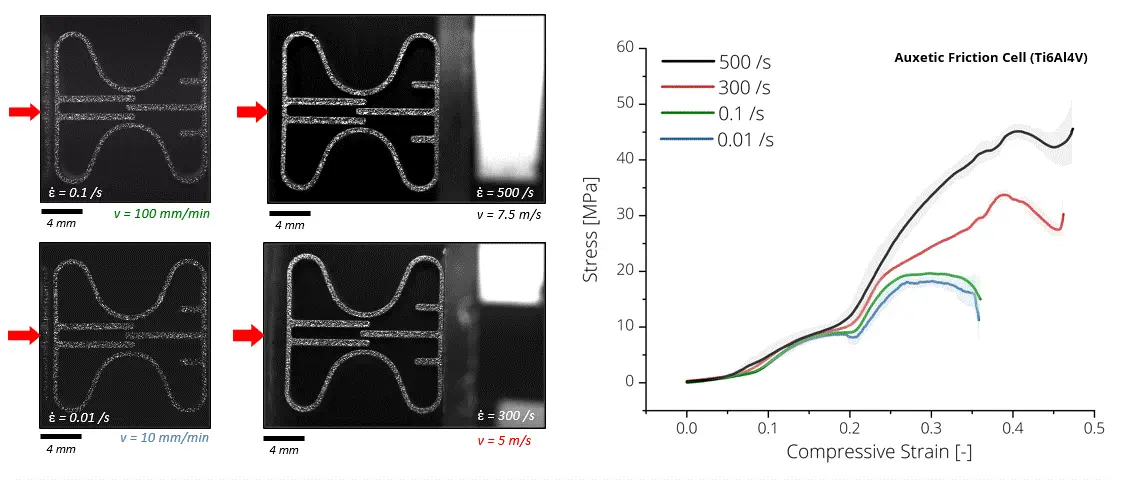Programming strain rate sensitivity into metamaterials
This research explores the feasibility of programming time-dependent damping behaviour into metamaterials, an attribute typically considered as an inherent material property. To date, the design of mechanical metamaterials has been focused almost exclusively on time-independent or quasi-static properties. Designing time-dependent mechanical properties is still a relatively unexplored field. However, it is precisely here, where a considerable need for advanced materials, e.g., for crash and impact protection, can be fulfilled. Instead of relying on the intrinsic time-dependence of a given material, one would like to prescribe it in the design phase, along with its shape and other quasi-static properties. To address the gap, we propose a friction-based unit cell mechanism (see Fig. 1) that results in strain rate sensitive behaviour, independent of the base material’s property. Friction is a time-dependent phenomena and we rely on friction to obtain strain rate sensitivity. The magnitude of the friction force is controlled by the geometry of the curved beams. Parametric optimization of the unit cell geometry, combined with the surface morphology of the sliding interfaces, is key to exploiting friction properties and achieving programmable strain rate sensitivity.
 |
|---|
| Unit cell design along with its key geometrical features. The vertical compressive load is redirected into displacement of the curved beams in horizontal direction, u. The central stems are pressed against each other creating contact pressure, thereby affecting the friction force. |
 |
|---|
| Experimental footage showcasing the compression of additively manufactured unit cells under varying strain rates. The high strain rate compression is performed at our Hopkinson bar laboratory. The designed mechanism adds significant strain rate sensitivity in comparison to the inherent base material (titanium alloy) property |
associated patent:
Sankalp Patil, Georg Ganzenmüller (2023). “A Deformable Structure”, Patent No: EP4148295 A1
associated publications:
- Sankalp Patil, Georg Ganzenmüller, Florian Gutmann, Klaus Hoschke, and Stefan Hiermaier. “The Auxetic Friction Cell: Towards programming strain rate dependency and energy dissipation into mechanical metamaterials.”, In: Materials Today Communications (2023), p. 106725. ISSN: 2352-4928. DOI: https://doi.org/10.1016/j.mtcomm.2023.106725
- Klaus Hoschke, Konstantin Kappe, Sankalp Patil, Sebastian Kilchert, Junseok Kim, Aron Pfaff. “Sustainability-Oriented Topology Optimization Towards a More Holistic Design for Additive Manufacturing.” In: Industrializing Additive Manufacturing (2024). AMPA 2023. Springer Tracts in Additive Manufacturing. Springer, Cham. DOI: https://doi.org/10.1007/978-3-031-42983-5_6
- Florian Gutmann, Maximilian Stilz, Sankalp Patil, Frank Fischer, Klaus Hoschke, Georg Ganzenmüller, and Stefan Hiermaier. “Miniaturization of Non-Assembly Metallic Pin-Joints by LPBF-Based Additive Manufacturing as Perfect Pivots for Pantographic Metamaterials.” In: Materials (2023), p. 1797. ISSN: 1996-1944. DOI: https://doi.org/10.3390/ma16051797
- Martin Huschka, Klaus Hoschke, Michael Dlugosch, Sankalp Patil, Christoph Schweizer, Valerie Friedmann, Gracia Elena Trelles, Johannes Preußner, Ulrich Klotz and Dario Tiberto, “Leichtbau: Datenvernetzung für additive Fertigung/Digitization of the process chain for additively manufactured aluminum lightweight components – Data fabric for lightweight design with AM”, In: wt Werkstattstechnik online (2022), p. 372-377. ISSN: 1436-4980. DOI: https://doi.org/10.37544/1436-4980-2022-06-22
- Georg. C. Ganzenmüller, Sankalp Patil, Michael Maurer, Martin Sauer, Markus Jung and Stefan Hiermaier. “A Simple Glassy Polymer Model. A Practical Framework for the Strain-Rate and Temperature Dependent Behaviour of Polycarbonate” In: Journal of Dynamic Behavior of Materials 5 (2019), p. 331–343. DOI: https://doi.org/10.1007/s40870-019-00216-9

